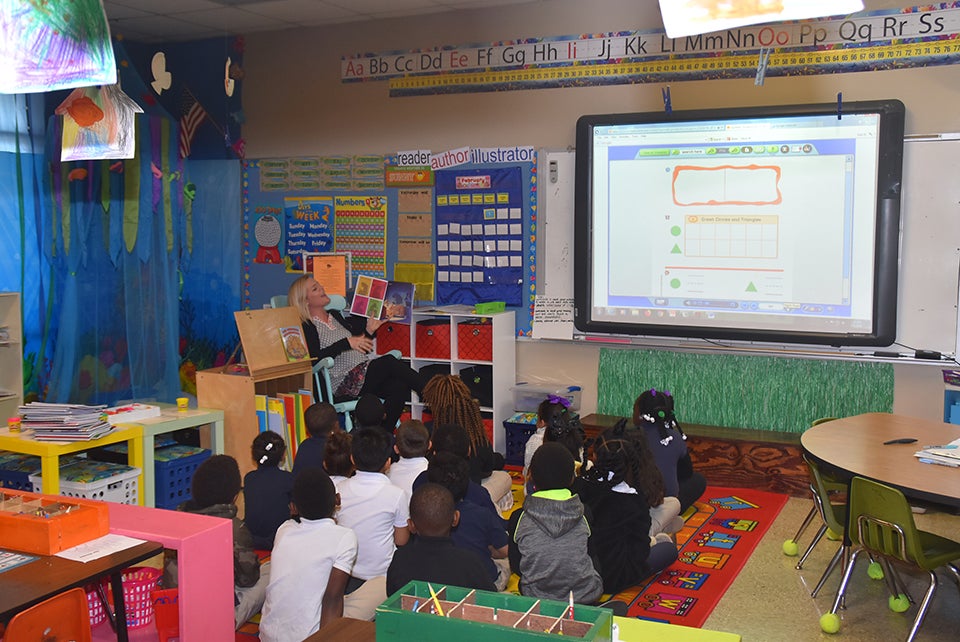Lanett City Schools have been breaking down barriers and providing opportunities
Published 11:30 pm Friday, February 2, 2018

- Students in Michelle Langley’s class listen to a story. (Photo by Steven Thomas)
LANETT — It’s been an interesting journey.
Lanett City Schools has been around for 120 years and in that time things have changed, from world wars to depressions and recessions.
Established in 1898 by the West Point Manufacturing Company, Lanett City Schools began its history by providing vibrant schools and abundant opportunities for a thriving textile center. A tradition of parental and community support as well as academic and athletic success began and in the following years, students benefitted from strong academic offerings delivered with high-quality instruction.
Lanett City Schools serves approximately 1,000 students in three Title I schools. The student body is represented by 78 percent African American, 11 percent White and 11 percent Hispanic. A reported free/reduced lunch rate of 92.26 percent indicates that many students in the district are experiencing poverty.
That success has only continued and recently I visited the schools for a tour with superintendent Phillip Johnson.
The trip started at the elementary school.
Johnson was eager to show off everything Lanett had to offer, from the media center and new technology to the classes and how the school goes about teaching.
The goal of the tour, according to Johnson, was to show how the school has worked to remove barriers to student achievement.
Lanett City Schools was created 120 years ago with a focus on the children of our community, and that has not changed, according to Johnson. Education and accountability are different now, and the stakes are higher. Lanett City is actively addressing barriers that can negatively affect student achievement, and the results are promising.
As described by the superintendent, Lanett City has implemented a Learning Supports model since 2014 to strategize ways to reduce learning barriers related to student achievement and daily well-being.
Lanett City teachers and administrators identified their major barriers to learning and achievement as 1) students’ lack of basic needs being met, 2) student mental and emotional health needs not being addressed, 3) health and chronic illnesses creating attendance issues, and 4) a lack of intrinsic motivation in many students leading to poor performance on standardized tests.
Principals reorganized their use of people and resources to focus on three main areas: targeted academic interventions, services for non-academic needs, and positive behavior supports.
While discussing this, we were joined by two people: Principal Jamie Heard and Assistant Principal Allyson Matthews.
The two additions were eager to show the changes brought about in recent years.
“Our classrooms are located in pods and usually the grade levels are close to one another,” Matthews said. “Logistically it’s great.”
A few more minutes of touring led into a planning room with walls covered in student data.
It was here that the administrators explained to me how the various bits of information show the students have been exceeding expectations.
They explained how the district uses a range of data sources to collect, analyze, and continually monitor the progress of students. These sources include state-mandated assessments, benchmark tests, grades, and intervention results. Enrichment opportunities, like the STEM Initiative, robotics, art, JROTC, career tech courses, technology, and state championship athletics, engage and support learners beyond the walls of the classroom.
Information provided to me shows that in grades 3-8 and 10, over 80 percent of all students in all levels are improving.
“Although overall student achievement is not yet at the desired level, teachers are excited about the individual growth that is taking place for a majority of our students,” Johnson said. “The growth data was impressive, and it showed that teachers are moving students from point A to point B in a year’s time.”
Leaving the data room, I was shown what I can only describe as a health area. Everything from speech therapy and mental well-being to general health were provided for.
As we were looking around we came across a school nurse. She spoke about what the school provided to students but also said she couldn’t talk too much because a pair of students were resting nearby, both trying to recover from the flu.
Principal Heard noted, “Lance Elementary is pleased to house the district’s new Wellness Clinic, where students can access a variety of medical and therapeutic services in one location. Hopefully, as we reduce the effects of health needs, we will see an increase in student achievement.”
Continuing on, we ended up visiting a number of classrooms. Some were actively being used, with some teachers reading to the children to others where the students had broken into smaller groups and were learning at their own pace.
Johnson made an effort to point out the English as a second language class. They were happy to explain how his efforts have helped bring down the language barrier that is increasingly affecting students.
The tour of the elementary school ended a little after half an hour. From there, Johnson and I traveled to the junior and high schools.
Immediately upon entering the junior high school, we were met by Principal Donna Bell.
It was here where the tour started to differ from the elementary school. More emphasis was placed on how the school was preparing students for college and technical schools, as well as the extracurricular activities available.
“At Lanett Junior High, we integrate enrichment and remediation opportunities into our daily schedule so that students can better retain and use the skills they have been taught,” Bell said.
We eventually transitioned into the high school where we ran into Principal Jennifer Boyd.
Out of all the others, Boyd showed off the options available to students.
“Lanett High School continues to focus on multiple measures of accountability. We are proud to offer options such as JROTC, Career Tech pathways, Advanced Placement classes, and dual enrollment opportunities to help our students graduate college- and career-ready,” she said.
Johnson was especially happy to point out what the schools offered in light of the recent release by the state labeling Lanett City School as “failing.”
In an earlier interview, Johnson described this decision as “wrong.”
“It’s asinine,” he said. “I don’t think it’s accurate.”
Johnson said results are determined by looking at the results of a test taken by the 10th grade class, which the students were not prepared for considering what the results are used for.
“It’s [taking the test] a lot of pressure,” he said, adding the test is unique to Alabama.
The list shows schools whose spring 2017 test results in math and reading on the ACT Aspire are in the lowest 6 percent of all schools in Alabama. The state’s board of education voted to drop the ACT Aspire last June and a permanent replacement test has not been named.
Johnson added the results were a surprise because last year the school received praise for the amount of AP readiness offered.
“I’m a bit deflated because even the state has no confidence in it,” he said, noting the school has seen much growth recently.
Lanett City Board of Education President Gwen Harris-Brooks, in a message given to me by Johnson, “We’ve seen incremental improvement in test scores for the last couple of years, and I believe that with staff members reducing barriers on a daily basis we may be able to make more progress in coming years. We have had churches and community organizations step up to provide tutoring for students and back pack meals for the weekends, and the city provides an after-school enrichment program for students needing additional support. It truly takes a village, and our village is working hard. When the state is able to finalize a consistent assessment system, I believe continued improvement will come at a faster pace.”




